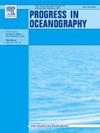气候变化下北极食物网中猎物与捕食者之间相互作用的变化
IF 3.6
3区 地球科学
Q1 OCEANOGRAPHY
引用次数: 0
摘要
全球变暖通过改变环境条件、生态系统结构和生态系统功能来影响海洋生态系统。在北极的部分地区,海温升高和海冰减少导致北方物种向极地扩展,并增加了它们与北极本地物种的相互作用。为了研究和量化新环境条件下北极海洋食物网中不断变化的相互作用,我们研究了巴伦支海季节性冰覆盖部分的主要猎食鱼类物种:成年极地鳕鱼(Boreogadus saida)和毛鳞鱼(Mallotus villosus)与该系统中主要捕食者之一大西洋鳕鱼(Gadus morhua)之间的相互作用:大西洋鳕鱼(Gadus morhua)。为此,我们比较了预测极地鳕鱼成鱼丰度与大西洋鳕鱼丰度函数的阈值模型的预测性能。每个模型都与一个假设相关联,该假设描述了在不同环境条件下猎物与捕食者之间的相互作用,这些环境条件由夏季海冰或毛鳞鱼种群生物量的临界值定义。最佳预测模型显示,在夏季海冰覆盖率低和毛鳞鱼种群生物量低的年份,大西洋鳕鱼对极地鳕鱼的捕食效应最强。我们的研究结果说明,在气候变化下,北极鳕鱼等北极物种可能会受到大西洋鳕鱼等北方物种更大的捕食压力。然而,这些影响不仅取决于物种分布的非生物驱动因素的变化,还取决于涉及中营养级物种(如毛鳞鱼)的食物网相互作用。本文章由计算机程序翻译,如有差异,请以英文原文为准。
Changes in prey-predator interactions in an Arctic food web under climate change
Global warming affects marine ecosystems by changing environmental conditions, ecosystem structure, and ecosystem functioning. In parts of the Arctic, increased sea temperature and decreased sea ice have led to a poleward expansion of boreal species and increased their interactions with native Arctic species. To investigate and quantify the changing interactions in an Arctic marine food web under new environmental conditions, we studied the interactions between key prey fish species in the seasonally ice-covered parts of the Barents Sea: adult polar cod (Boreogadus saida) and capelin (Mallotus villosus) and one of the major predators in the system: Atlantic cod (Gadus morhua). For this, we compared the predictive performance of threshold models predicting the abundance of adult polar cod as a function of Atlantic cod. Each model was associated with a hypothesis describing prey-predator interactions in different environmental conditions defined by threshold values of summer sea-ice or capelin stock biomass. The best predictive model showed that the predation effect of Atlantic cod on polar cod was strongest in years of low summer sea ice cover and low capelin stock biomass. Our results exemplified that Arctic species such as polar cod may experience increased predation pressure under climate change from boreal species such as Atlantic cod. These effects depend, however, not only on changes in abiotic drivers of species distributions, but also on food-web interactions involving mid-trophic level species such as capelin.
求助全文
通过发布文献求助,成功后即可免费获取论文全文。
去求助
来源期刊

Progress in Oceanography
地学-海洋学
CiteScore
7.20
自引率
4.90%
发文量
138
审稿时长
3 months
期刊介绍:
Progress in Oceanography publishes the longer, more comprehensive papers that most oceanographers feel are necessary, on occasion, to do justice to their work. Contributions are generally either a review of an aspect of oceanography or a treatise on an expanding oceanographic subject. The articles cover the entire spectrum of disciplines within the science of oceanography. Occasionally volumes are devoted to collections of papers and conference proceedings of exceptional interest. Essential reading for all oceanographers.
 求助内容:
求助内容: 应助结果提醒方式:
应助结果提醒方式:


